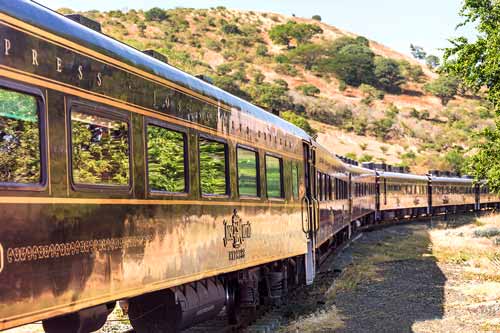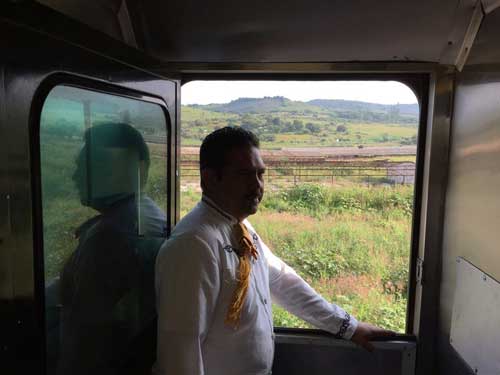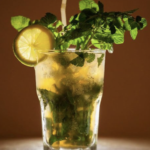Learning about tequila it in the namesake town and region will give you a whole new respect (and hopefully no hangover) for tequila.
Fields of agave in Tequila.
I recently brought a little bit of Mexico home, hosting a tequila tasting for my friends in the Washington, DC area. I wanted to share stories from my travels in Mexico, show off my newly learned tequila tasting skills and use the cheesy shot glass I brought specifically for the occasion in Mexico. I returned from a place that I didn’t know existed. A place called Tequila, where for hundreds of years tequila has been distilled and perfected for tastings.
Views on the Jose Cuervo Express, which stops in Tequila.
I hopped a train, the Jose Cuervo Express, from Guadalajara, the capital of the Mexican state of Jalisco. Train travel is a great way to take in the countryside and the train ride to Tequila is both scenic and festive. If you might enjoy having a margarita with your breakfast, you can do so on the train, where snacks and, of course, tequila are served.

Passing fields of agave, the plant from which tequila is made, you know you’re getting close to Tequila. This town is designated as a Pueblo Mágico or Magical Town, due to its rich culture and history. The Agave Landscape also holds a special designation by UNESCO as a World Heritage Site.

The two hour train ride is both interesting and peaceful, as the scenery changes from urban to rural. You know you’re getting close as you breeze past valleys of blue agave stretching to the horizon. Resting at the bottom of the Tequila volcano, the valley’s mineral rich soil along with its semi-arid climate make growing conditions perfect for harvesting agave azul, blue agave, the basis for tequila. Upon departing the train, we took a bus to the agave fields where our education in tequila making would begin.
Field to Distillery
Like true Champagne from the Champagne wine region in France, Tequila can’t come from just anywhere. To be called Tequila, the blue agave plant must be grown in the state of Jalisco and specific regions in the states of Guanajuato, Michoacan, Nayarit and Tamaulipas. It’s a labor intensive process involving a jimador, a skilled harvester of the plants who likely has learned the craft from his parents.

With the backdrop of the Tequila volcano and, of course, a margarita, I watched as a dashing, mustached jimador dressed in a cowboy hat, white button down shirt and jeans used a coa, a hoe-like tool with a sharp blade, to slice off the spikey green-blue colored stalks and show us the core of the agave, called the piña. Aptly named, it resembles a pineapple. It’s this bulbous core that is hauled to the distillery for processing, but only after it’s been allowed to mature in the fields over a period of eight to 12 years. During this time, the plant is pruned and taken care of to ensure healthy ripening and growth.
The “jimador” during the labor intensive process of cutting and preparing the blue agave to be sent to the distillery.
Tequila Distillery Tour
Back in town steps away from the main cobblestoned square, we started our tour of La Rojeña, Cuervo’s oldest distillery and said to be the oldest active tequila distillery in the Western Hemisphere. Our first stop was the ovens where the piña are split apart and then cooked for 36 to 40 hours. Split apart upon cooling, it is at this point that we were able to taste the cooked agave, often described as having a sweet potato or burnt honey texture and flavor. To me it tasted sweet, like tequila candy.

These agave chunks are then pressed to extract the juices, which are then fermented and distilled to create various kinds of tequila. To be called tequila, the spirit must be made in one of the designated Tequila regions in Mexico and also contain at least 51% blue agave. The blends are called mixto and won’t be labeled as 100% tequila, as they contain added water and sugar. Even deeper than that, there are more types of tequila, including reposado, which is aged a minimum of two months, but not more than a year, in oak barrels, blanco, which is not aged and is bottled or stored immediately after distillation, or aged less than 60 days and usually in stainless steel tanks… and more. Before my tour, I figured tequila was just tequila, but I was beginning to understand that the world of tequila is as complex as the drink itself.
Our final stop on our tour was the Reserva de la Familia Cellar. Once reserved only for members of the Cuervo family, guests may now sign up for a tour that includes a visit. In the dimly lit cellar, my group and I sat on benches at a long wooden table surrounded by barrels, eagerly awaiting the opportunity to taste tequila straight from a barrel––110 proof tequila that had been aged for seven years, to be exact. Before my tequila tasting and tour, I had thought of tequila as a not-too-pleasant drink that would likely cause a bad hangover and get you pretty drunk prior to that. Though 110 proof tequila is super strong, it was also extremely smooth.
Another experience that’s open to the public and one of the higher priced tour options is a visit to the old hacienda. We entered the large wooden doors of the hacienda, which is just across the street from the distillery, and were greeted with explosions of confetti and colorfully clad dancers. I was surprised and impressed by the festivities, including cowboys on horseback, colorfully dressed dancers and another chance to learn more about how to pair tequila with a variety of surprising foods, including cheese and chocolate.
Tasting Tequila- What you need to know and how to share
For those of you reading this that are thinking, this is great, but I’m not going to the town of Tequila anytime soon, how can I enjoy tasting tequila and perhaps share it with my friends… Here’s what I did on my tasting in an attempt to recreate the enjoyable, educational and hangover-free experience I had in Mexico.
I used the three varieties below from Maestro Tequilero, produced by Cuervo in Mexico, and had happy and surprised guests, who, like me, had previously only tried not-so-great tequila. Substitute your favorite brand and sip away. At home, I used miniature, shot-sized wine glasses (a small brandy snifter, or something that’s tapered at the top is the best type of glass to use) and encouraged guests to swirl, smell and sip, similarly to a wine tasting.
Tequila Tasting Menu Suggestions
Tequila Blanco, also called White or Silver Tequila, is 100% blue agave (no sugar added) and clear in color. Pair your favorite brand with citrus, including ceviche or chips and salsa or try it with lime and sugar.
My Tequila tasting party… cheesy shot glass included.

Tequila Reposado is aged or “rested” in white oak barrels for two months to a year, giving it a mellow oak flavor while still bringing out the taste of the blue agave. It pairs well with garlic shrimp, chile spiced foods and buttery cheeses and is especially good with Buttermilk Blue Roth Kase Cheese. Ask your grocer for something similar if you can’t find it.
Tequila Añejo is aged in white oak barrels for over a year in small batches. The longer aging process gives the tequila a stronger oak and more complex flavor, sort of like Scotch. It pairs well with beef and desserts. I paired it with semi-sweet Ghirardelli Chocolate.
Like any strong alcoholic beverage, drink in moderation and enjoy! You might be surprised at how much you like tequila. Oh, and if you do throw a tasting, let me know how it goes and what you did. There are lots of different tequila pairings. Who knows? With your recommendations, I may decide to throw another tasting bash of my own!
How you can go: You can reach the town of Tequila by driving. It’s about an hour from Guadalajara and four hours from Puerto Vallarta. There are regular tours and tastings at several area distilleries. The basic Jose Cuervo Experience tour and tasting starts at around $20 USD per adult ($300 MXN). The Jose Cuervo Express takes you right from Guadalajara into the town of Tequila. Packages that include the two hour train ride, a tour of Jose Cuervo’s La Rojeña distillery and more start at around $92 USD ($1,350 MXN) and run Fridays, Saturdays and Sundays. Other popular distilleries in Tequila open for tours include Sauza and La Cofradia.
Travelers can also explore the tequila region on the Tequila Express train, which also departs from Guadalajara, but does not visit the town of Tequila. It takes travelers on a guided tour of the Herradura distillery in Amatitán.



